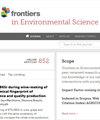Pharmaceutical consumption in human and veterinary medicine in Germany: potential environmental challenges
IF 3.3
3区 环境科学与生态学
Q2 ENVIRONMENTAL SCIENCES
引用次数: 0
Abstract
Pharmaceutical usage in both human and veterinary medicine contributes substantially to societal wellbeing. However, concerns regarding its environmental impacts are increasing. Despite global awareness, a substantial knowledge gap exists in Germany and several other countries regarding pharmaceutical residues, hindering comprehensive environmental risk assessments. This study aims to bridge this gap by analyzing veterinary pharmaceutical consumption in livestock farming in Germany and comparing it with human pharmaceutical usage, subsequently correlating these findings with environmental data on pharmaceutical residues to conduct a straightforward analysis of the environmental risk posed on non-target entities such as soil, water bodies, and microorganisms. Data from 129 agricultural farms in Germany were utilized to comprehensively analyze veterinary pharmaceutical usage. Extrapolation to national levels estimates a substantial quantity of active substances used, particularly antibiotics and electrolytes. Comparison with human pharmaceutical usage highlights differences in substance prevalence and usage patterns. Environmental correlations indicate a considerable presence of pharmaceutical residues in Germany, with notable distinctions between human and veterinary sources. In the environmental risk analysis, significant differences are evident between individual active substances within the same substance group. The study underscores the importance of addressing pharmaceutical residue impacts on the environment and emphasizes the necessity of comprehensive data for informed decision-making and environmental management strategies.德国人用和兽医用药:潜在的环境挑战
人类和兽医用药对社会福祉做出了巨大贡献。然而,人们对其环境影响的担忧与日俱增。尽管全球都意识到了这一点,但德国和其他一些国家在药物残留方面还存在很大的知识差距,阻碍了全面的环境风险评估。本研究旨在通过分析德国畜牧业中的兽药消耗量,并将其与人类用药量进行比较,然后将这些发现与药物残留的环境数据进行关联,从而对土壤、水体和微生物等非目标实体造成的环境风险进行直接分析,从而弥补这一差距。我们利用德国 129 个农场的数据对兽药使用情况进行了全面分析。根据全国水平推断,估计使用了大量活性物质,尤其是抗生素和电解质。通过与人类药物使用情况进行比较,可以发现两者在药物使用率和使用模式上存在差异。环境相关性表明,德国存在大量药物残留,其中人类和兽医来源的药物残留有明显区别。在环境风险分析中,同一物质组中不同活性物质之间存在明显差异。这项研究强调了解决药物残留对环境影响问题的重要性,并强调了全面数据对于知情决策和环境管理战略的必要性。
本文章由计算机程序翻译,如有差异,请以英文原文为准。
求助全文
约1分钟内获得全文
求助全文
来源期刊

Frontiers in Environmental Science
Environmental Science-General Environmental Science
CiteScore
4.50
自引率
8.70%
发文量
2276
审稿时长
12 weeks
期刊介绍:
Our natural world is experiencing a state of rapid change unprecedented in the presence of humans. The changes affect virtually all physical, chemical and biological systems on Earth. The interaction of these systems leads to tipping points, feedbacks and amplification of effects. In virtually all cases, the causes of environmental change can be traced to human activity through either direct interventions as a consequence of pollution, or through global warming from greenhouse case emissions. Well-formulated and internationally-relevant policies to mitigate the change, or adapt to the consequences, that will ensure our ability to thrive in the coming decades are badly needed. Without proper understanding of the processes involved, and deep understanding of the likely impacts of bad decisions or inaction, the security of food, water and energy is a risk. Left unchecked shortages of these basic commodities will lead to migration, global geopolitical tension and conflict. This represents the major challenge of our time. We are the first generation to appreciate the problem and we will be judged in future by our ability to determine and take the action necessary. Appropriate knowledge of the condition of our natural world, appreciation of the changes occurring, and predictions of how the future will develop are requisite to the definition and implementation of solutions.
Frontiers in Environmental Science publishes research at the cutting edge of knowledge of our natural world and its various intersections with society. It bridges between the identification and measurement of change, comprehension of the processes responsible, and the measures needed to reduce their impact. Its aim is to assist the formulation of policies, by offering sound scientific evidence on environmental science, that will lead to a more inhabitable and sustainable world for the generations to come.
 求助内容:
求助内容: 应助结果提醒方式:
应助结果提醒方式:


